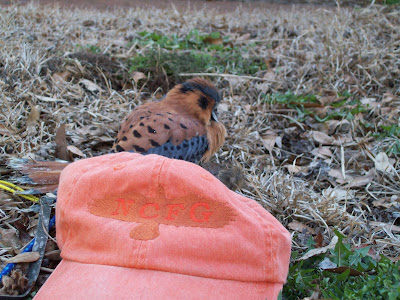It started off that we needed to relocate an opossum. He's done this before, but he wanted to bring the camera and take pictures. No big deal, I thought. I released the critter and he clicked away.

This one had been pregnant, and I felt pretty good about letting her go, even though I am not a big fan of opossums. On the way to Ace, we saw some osprey, and Luke wanted to see if he could get a picture. We followed the bird to a spot where I knew there was a nest. He couldn't get a picture of the bird flying, but we could just see the head of the adult female peeking over the edge of the nest. It seemed obvious to both of us that she was on eggs, and Luke decided that we needed to check on her every two weeks or so and see how the chicks were coming. I wasn't going to complain.

We wandered down the nearby nature trail, looking for a water moccasin. I wanted a picture. They have got to be the most common snakes that we have on the Outer Banks. But it must not have been warm enough. It was around seventy today, and the turtles were out in force, but the water was still cold, so I'm not sure where the cotton mouths were hiding.
Luke was perfectly happy to follow the progress of one of the many geese that we have been seeing in the area.

He loves animals, and he loves being outside. All my kids love to camp, they love to hike and every one enjoys a good day of fishing for bluegill.
I think spending days outside like this is really important to kids. Let them know what they can find if they just spend some time outside. We finally made it to Ace and picked up the things that I needed, but Luke wasn't done. At our house we do a lot of things with our natural resources. we can fruit and vegetables, we make wine, we grow fruit on our trees, but unfortunately, we are failed gardeners. Luke decided that that would no longer be the case. He had started an herb garden in the window earlier this winter, but now it was time to try vegetables. He doesn't even like vegetables.
So we pulled some wood around from behind the shed and put together some raised boxes. We dug up the soil from the bottom of the compost pile, mixed in some rabbit poo and chicken scat, and swirled it all together into an effervescent pile of dirty goodness.

Then started to plant.

That was Luke's job. He got a shovel and trowel for Christmas and this was his chance to use them. He read the directions on the seed packets, dug some holes and planted the seeds, labeling each row with a neatly written post.

We got one box done. Seeds are in and labeled. The second box has a bit more chicken scat in it, so it needs a bit of time to mellow. We'll be planting that one in a couple of weeks.

My kids, like most, still enjoy the TV. They like the occasional video game. But, they love to be outdoors. I don't think that it come by accident. Next time you take a walk. Next time you plant, or can, make jelly, or hunt, what are you teaching your children about the outdoors?
Whatever it is, make sure that you take the time to make them realize how important time outdoors really is, like these guys did.
















































